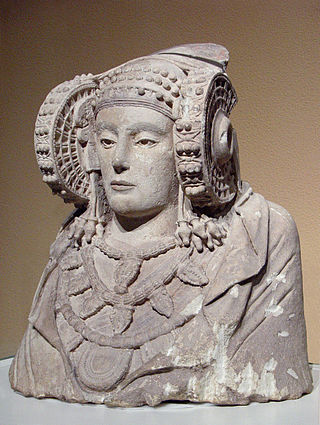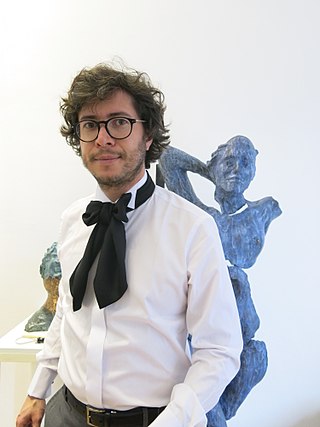Related Research Articles

The Prado Museum, officially known as Museo Nacional del Prado, is the main Spanish national art museum, located in central Madrid. It houses collections of European art, dating from the 12th century to the early 20th century, based on the former Spanish royal collection, and the single best collection of Spanish art. Founded as a museum of paintings and sculpture in 1819, it also contains important collections of other types of works. The numerous works by Francisco Goya, the single most extensively represented artist, as well as by Hieronymus Bosch, El Greco, Peter Paul Rubens, Titian, and Diego Velázquez, are some of the highlights of the collection. Velázquez and his keen eye and sensibility were also responsible for bringing much of the museum's fine collection of Italian masters to Spain, now one of the largest outside of Italy.

The Museo Nacional Centro de Arte Reina Sofía is Spain's national museum of 20th-century art. The museum was officially inaugurated on September 10, 1992, and is named for Queen Sofía. It is located in Madrid, near the Atocha train and metro stations, at the southern end of the so-called Golden Triangle of Art.

The Lady of Elche is a limestone bust that was discovered in 1897, at La Alcudia, an archaeological site on a private estate two kilometers south of Elche, Spain. It is now exhibited in the National Archaeological Museum of Spain in Madrid.

Guernica is a large 1937 oil painting by Spanish artist Pablo Picasso. It is one of his best-known works, regarded by many art critics as the most moving and powerful anti-war painting in history. It is exhibited in the Museo Reina Sofía in Madrid.

Julio González i Pellicer, born in Barcelona, was a Spanish sculptor and painter who developed the expressive use of iron as a medium for modern sculpture. He was from a lineage of metalsmith workers and artists. His grandfather was a goldsmith worker and his father, Concordio González, a metalsmith worker who taught him the techniques of metalsmith in his childhood years. His mother, Pilar Pellicer Fenés, came from a long line of artists.

The National Archaeological Museum is a museum in Madrid, Spain. It is located on Calle de Serrano beside the Plaza de Colón, sharing its building with the National Library of Spain.

The Casón del Buen Retiro is an annex of the Museo del Prado complex in Madrid. Following major restoration work, which was completed in October 2007, it now houses the museum's study centre and library.
Pablo Serrano Aguilar, was a Spanish abstract sculptor.
The Museum of Outdoor Sculpture of Alcala de Henares is a permanent exhibition of contemporary art in public Alcalá de Henares, opened in 1993 and organized by the sculptor José Noja.
Eusebio Sempere Juan was a Spanish sculptor, painter, and graphic artist whose abstract geometric works make him the most representative artist of the Kinetic art movement in Spain and one of Spain's foremost artists. His use of repetition of line and mastery of color to manipulate the way light plays on the surface give depth to his pictorial compositions.
Miquel Navarro is a Spanish sculptor, painter and contemporary poet.

Teddy Cobeña Loor is a figurative expressionist sculptor with a surrealist component. He lives in Barcelona.

Mustafa Hamed Moh Arruf is a Spanish sculptor.

José Guirao Cabrera was a Spanish cultural manager and art expert who served as Minister of Culture and Sport in the government of Pedro Sánchez between 2018 and 2020. He was also Member of the Congress of Deputies.

The equestrian statue of Augustus is a bronze statue of Augustus, the first Roman emperor, riding a horse. It dates from 2007 and is in Mérida, Spain, located on a roundabout at the intersection of the Avenida de Portugal and the Avenida Reina Sofía. Emerita Augusta, today Mérida, was founded as a Roman colony in 25 BC at the order of Augustus to serve as a retreat for the veteran soldiers (emeritus) of the legions V Alaudae and X Gemina.
Alberto Corazón Climent was a Spanish multidisciplinary artist who combined graphic design, sculpture, painting, and photography into his works. Some of his works are housed at contemporary museums including Bilbao Fine Arts Museum, Museum of Contemporary Art, Madrid, and Institut Valencià d'Art Modern. He worked as a graphic designer for clients including the organizations National Library of Spain, Autonomous University of Madrid, Anaya, ONCE, Círculo de Bellas Artes, and Renfe Operadora. He was inducted as the member of the Real Academia de Bellas Artes de San Fernando in 2006.

The Covo Island, better known as the Island of Sculptures or Illa das Esculturas in Galician, is a park and island located near the mouth of the Lérez River, in Pontevedra, Spain. It has an area of 70,000 m² and is connected to both banks of the river by footbridges and pedestrian bridges. It is the largest and most important open-air museum in Galicia and one of the most important in Spain.

Valle-Inclán, is a sculpture created by the Spanish sculptor César Lombera, located in Pontevedra (Spain). It is located in Plaza Méndez Núñez and was inaugurated on 26 June 2003.

The Young Woman of Amajac is a pre-Hispanic sculpture depicting an indigenous woman. It was discovered by farmers in January 2021 in the Huasteca region, in eastern Mexico.
Maria Alos (1973–2011) was an interdisciplinary artist who lived and worked in Mexico City and New York. She received a MFA from Syracuse University (2000) in New York. Throughout her artistic career, she created various installations, performances, and archives for museums and public spaces in the United States, Latin America, and Europe.
References
- ↑ "Equal-Parallel: Guernica-Bengasi". museoreinasofia.es. Museo Nacional Centro de Arte Reina Sofia. Retrieved 5 December 2017.
- 1 2 "Madrid 'mislays' Serra sculpture". BBC News. 19 January 2006. Retrieved 3 December 2017.
- 1 2 "El Reina Sofía ha 'perdido' una escultura de 38 toneladas que dejó en depósito hace 14 años" [The Reina Sofía has 'lost' a 38-ton sculpture that it left in storage 14 years ago]. El Mundo (in Spanish). Madrid, Spain. 19 January 2006. Retrieved 5 December 2017.
- ↑ Tremlett, Giles (19 January 2006). "Museum discovers loss of 38-tonne sculpture". The Guardian. Madrid, Spain. Retrieved 5 December 2017.
- ↑ "La escultura robada de richard serra vuelve a verse desde manana en el reina sofía en una réplica gemela" [Richard Serra's stolen sculpture can be seen again from tomorrow at the Reina Sofía in a twin replica]. El Economist (in Spanish). Madrid, Spain. 10 February 2009. Retrieved 5 December 2017.